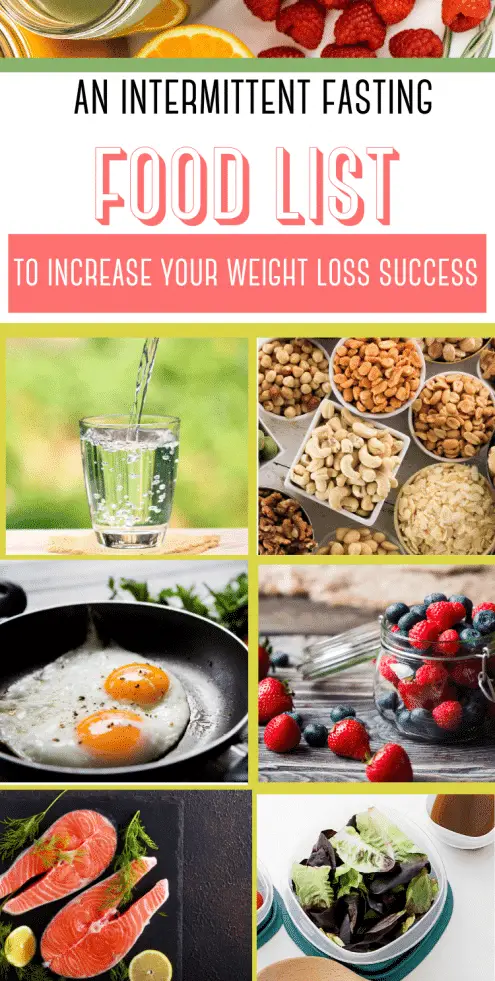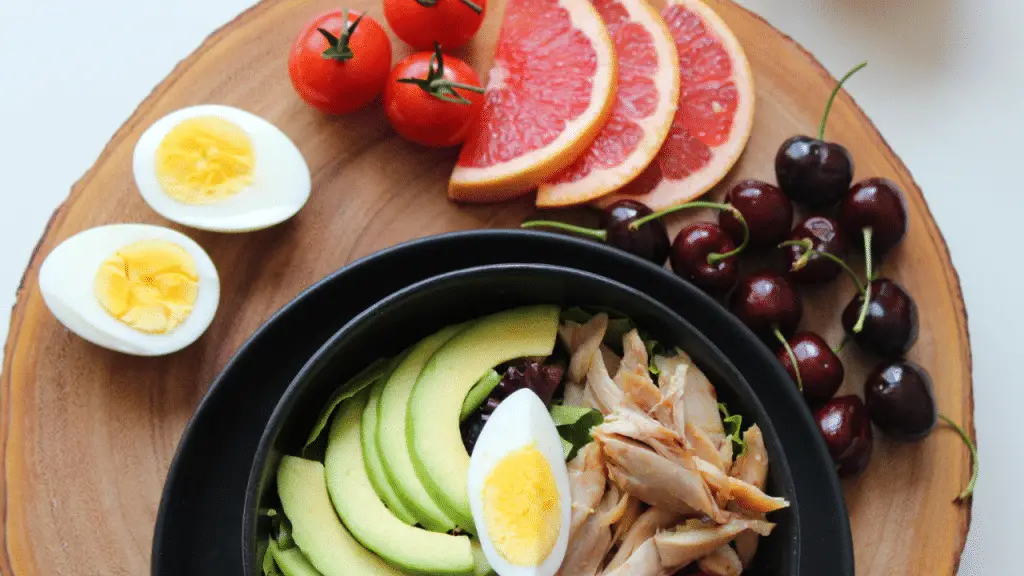Before we start with this intermittent fasting food list, let me just put it simply: the foods you should eat when intermittent fasting are the same foods you should eat when you are not on intermittent fasting. Right? Why would intermittent fasting change anything?
However, some foods will support your choice to practice intermittent fasting and help you lose weight faster. Let’s talk about what they are.

Overall Food Guidelines
Before we get into our intermittent fasting food list, I have a few guidelines to help you improve your food choices. If you strive to follow these guidelines, you will be well on your way to consuming the foods your body needs without even looking at a food list:
- Avoid sugar: Avoiding sugar will help stabilize your insulin levels and reduce cravings.
- Eat one large salad a day: A salad rich in healthy fats will make you feel satisfied and reduce your desire for other foods.
- Eat 2 cups of cooked nonstarchy vegetables daily: nonstarchy vegetables are a nutrition powerhouse. Furthermore, they fill you up fast.
- Stop eating at least 2 hours before bed: This will improve the quality of your sleep and mark the beginning of your intermittent fasting window.
It’s that simple! No need to complicate things!
Intermittent Fasting Food List
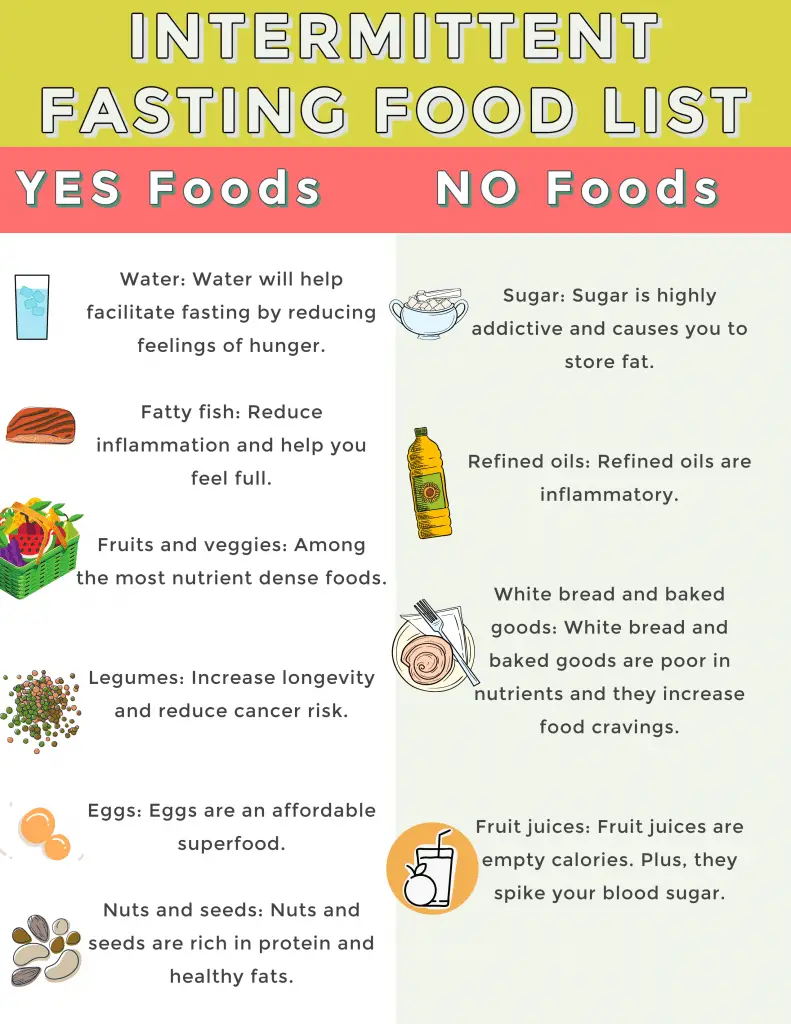
Yes Foods
This Yes Food List is by no means exhaustive. You can have many other foods. It simply includes all my favorite nutrient-dense superfoods.
Water
Water isn’t food, but it is so important! You must ensure you stay hydrated when fasting and after you break your fast. Frequently, water will help reduce your hunger. Drinking enough water will increase your overall well-being. Drink one ounce of water per pound of body weight.
If your urine is dark yellow, you are not drinking enough water. You are at risk for headaches, dizziness, and fatigue, particularly when you fast.
Fatty Fish
I know many are concerned about the mercury found in fish and seafood. I think the benefits outweigh the risks. Stick to wild fish, and avoid farmed fish. Otherwise, fatty fish is high in Omega-3 (which reduces inflammation). It offers a host of health benefits:
- Helps reduce cancer risks
- Protects vision and memory
- Reduce risks of asthma
- Improves cognitive function
- Protects against cardiovascular diseases
- Lowers the risk of rheumatoid arthritis
Fruits and Vegetables (Even White Potatoes!)
Yes, I spent years avoiding white potatoes while on a Paleo diet. I felt amazing for quite a while, but when I started reacting to more and more foods, I realized that the Paleo diet was not a long-term solution for me. That’s why I started experimenting with supplements and fasting. Some of my favorite fruits and vegetables are:
- Cruciferous vegetables: Broccoli, Brussel Sprouts, cabbage, cauliflower, kale, arugula, bok choy, etc. Learn more about the benefits of cruciferous vegetables in my post Best Detoxifying Vegetables to Start Including In Your Diet Today.
- Avocado: Avocado is a healthy-fat-rich fruit that will help satisfy your meals. Avocado helps keep you full longer.
- Berries: These little jewels are filled with antioxidants and are low in carbs.
- White Potatoes: Haha! I bet some of you have already clicked away from this site! If you are still here, great! I am not saying to eat potato chips or store-bought french fries. I am saying that for most of us, the white potato fear is unwarranted. White potatoes have more protein and potassium than sweet potatoes. I was surprised to learn that one white potato contains 4.3 grams of protein! Read this interesting article that compares sweet and white potatoes. Moreover, cooked and cooled white potatoes (like in potato salad) are an excellent source of resistant starch. Resistant starch feeds your good gut bacteria.
All fruits and vegetables are nutrient-dense, and you cannot eat too much. Fruits and vegetables should constitute the bulk of your diet. I know some people feel amazing on a carnivore diet, and I respect that. I am not the one who is going to discourage you from giving it a try. This post aims to give some general guidelines to help you create your own sustainable lifestyle using a simple intermittent fasting food list.
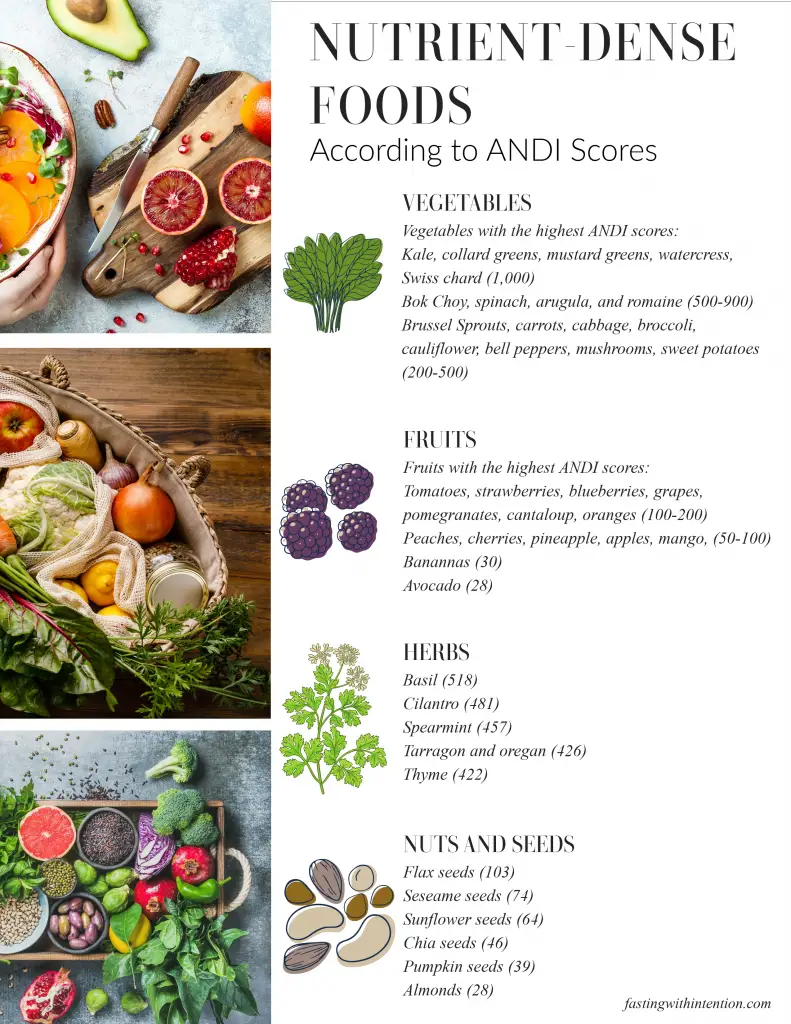
Beans and Legumes
Beans and legumes are another somewhat contentious food. Some people experience digestive distress, and there is the issue of anti-nutrients. I avoided phytates as much as possible by soaking my nuts and not eating legumes. I no longer worry about it. Moreover, there is enough evidence that legumes are an important part of a balanced diet that increases longevity. I find the concept of the Blue Zones very interesting. The Blue Zones are where we find the highest concentration of centenarians. Well, it turns out that one common thread among them is eating legumes (one cup daily).
Another health benefit of legumes is that they reduce cancer risks.
Eggs
Eggs are a superfood. They are packed with nutrients:
- Vitamin A, the B vitamins, vitamin D, vitamin E, and vitamin K
- Selenium
- Phosphorus
- Calcium
- Zinc
- Protein
- Folate
- Healthy fats
Plus, they are cheap and easy to prepare. Yes, they contain cholesterol, but that’s not necessarily bad. Cholesterol has many functions in your body, like aiding in producing hormones like estrogen and cholesterol.
Nuts and Seed
Nuts contain lots of good fats, fiber, minerals, and protein. l love eating a handful to break my fast with my Power Shake. I love sprinkling them on salads, too. If you are keto, be aware that they also contain many carbs. However, they are an excellent addition to your diet either way. Check out my Low Carb Food List for more info about the number of carbs in nuts.

My favorite nuts are
- Macadamia nuts
- Pistachios
- Almonds
- Pecans
- Walnuts
- Brazil Nuts
A handful of mixed nuts contains 5 grams of protein, 16 grams of fat, and 6 grams of carbs.
A Word to Beef Lovers
When I make lists like this one, I get the occasional beef lover who asks why I didn’t include beef on my list. You probably noticed I didn’t mention other protein sources like poultry. Of course, you can have them! I just decided to include my top favorite foods. Beef and poultry are excellent food choices when you practice intermittent fasting and when you don’t. However, it is somewhat controversial as well. Some studies suggest red meat increases cancer risks. And then, there is the grass-fed vs. feedlot beef issue.
This chart is a good visual:
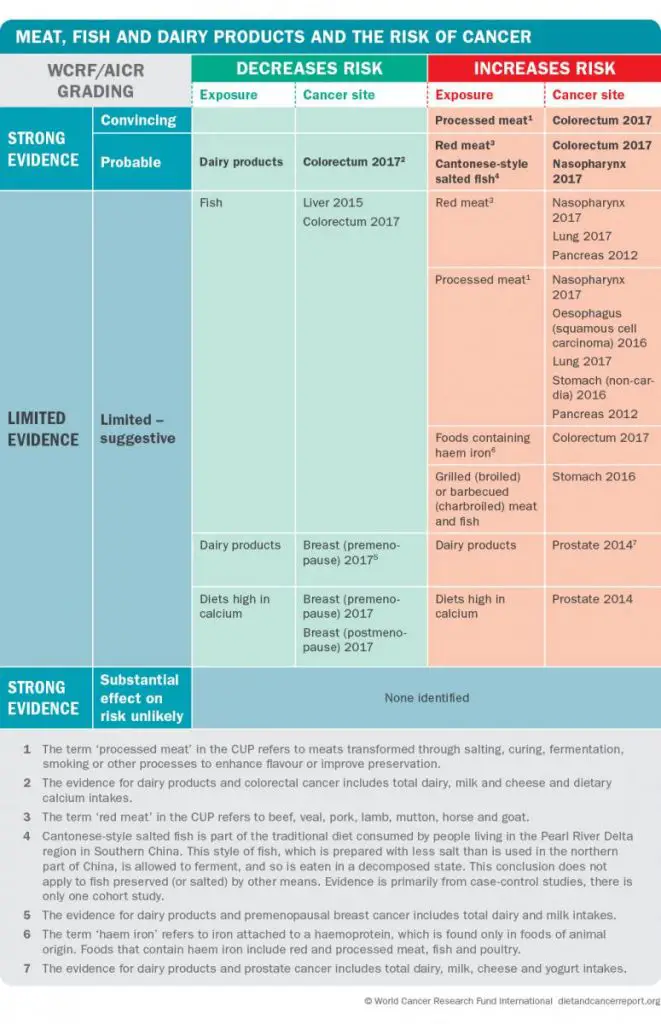
I am not going to dwell on the issue. Do your research and make your own decision.
No Foods
These are the foods you should limit as much as possible. In my mind, intermittent fasting is all about food freedom. Therefore, the goal of my intermittent fasting food list is not to impose restrictions that you will follow blindly. Let these serve as guidelines to help you make better food choices.
White Sugar
Avoiding sugar and refined oils will eliminate most processed foods from your grocery list. Sugar is everywhere, and it is highly addictive. Did you know that the average person consumes 17 teaspoons of sugar daily? Meanwhile, a reasonable amount would be 6 teaspoons a day. Consuming sugar stimulates the pleasure center of your brain (the same part that is stimulated when cocaine addicts consume cocaine). That’s why it’s not easy to break free from sugar!
How to Break Free From Sugar
Intermittent fasting will help because it will make you more insulin sensitive, which will help regulate your cravings. Here are some other measures you can take:
- Go keto at least temporarily: Going keto is a quick cold turkey way to get used the taste of foods without sugar. You will train your taste buds to enjoy savory foods and taste the natural sweetness in foods.
- Avoid all foods with added sugar: If you don’t want to do a “keto cleanse”, you can eliminate all added sugar from your diet. Fill up on healthy fats, nonstarchy vegetables, and protein.
- Try a modified fast: Similarly to the keto diet, a modified fast can help you break free from your sugar addiction. Learn more about modified fasting by reading Modified Fasting: How You Can Benefit From Fasting Without Giving Up Food.
- Brush your teeth: The next suggestions are little things you can do when cravings hit. Brushing your teeth often reduces your desire to eat.
- Eat mint
- Drink tea or coffee
- Lemon Water
- Apple cider vinegar: Still surprised by all the apple cider vinegar benefits I learned when writing my post Apple Cider Vinegar Fasting: Cut Down on Your Cravings and Feel Great.
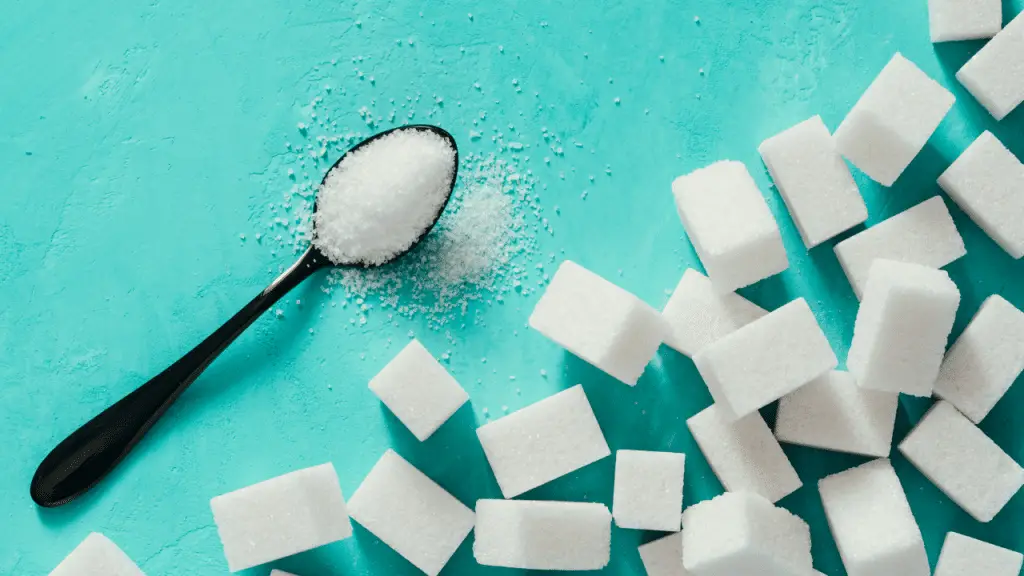
Refined Oils
Like eliminating sugar, eliminating refined oils will eliminate processed foods. In short, refined oils have been treated with harmful chemicals. For example, avoid:
- Canola oil
- Vegetable oil
- Soybean oil
- Safflower oil
- Corn oil
- Margarine
Hydrogenated oils are the worst (found in margarine and shortening). They have been banned in some countries. The process of hydrogenation turns unsaturated fat into solid fat by adding hydrogen.
White Bread and Baked Goods
Avoiding white bread and baked goods will improve your overall health as you will eat more nutrient-dense foods instead and help support your weight loss goals. White breaks and baked goods are addictive and contain little nutrition. Fill up on foods that support your health.
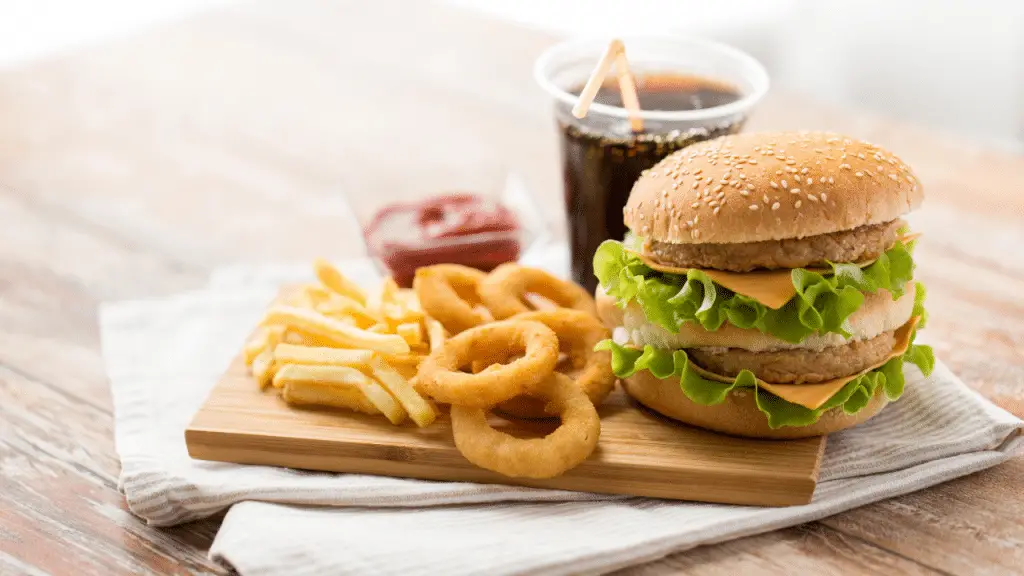
Fruit Juices
Even if they are completely natural, fruit juices tend to spike your blood sugar. They will increase your cravings and cause you to store more fat.
In Summary
Intermittent fasting gives you food freedom. It heals your body and reduces inflammation to such an extent that you may find it can handle some foods you couldn’t eat before (that was my experience). However, it doesn’t mean you should overindulge in these unhealthy inflammatory foods. Take care of your body. You only have one!
